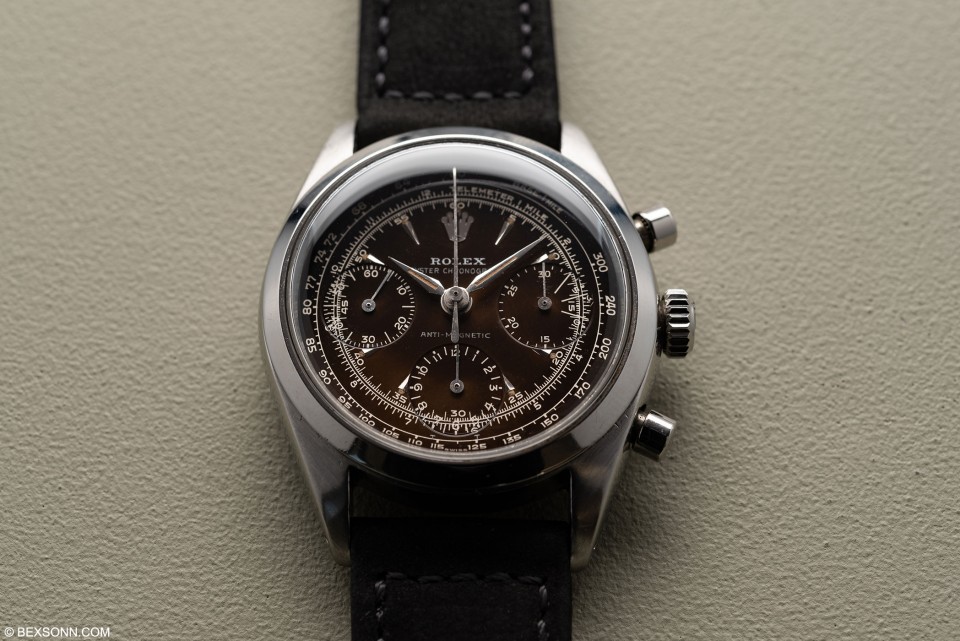It’s that time of the year again where all eyes are on Geneva for auction season. With that comes my highlights of what I think are some of the most interesting lots at Phillips’ Geneva Watch Auction: Eight. As usual, I tend to stay away from the more popular lots that have most likely been highlighted already, however, some of them were just too damn good to resist.
ROLEX DAYTONA 6265
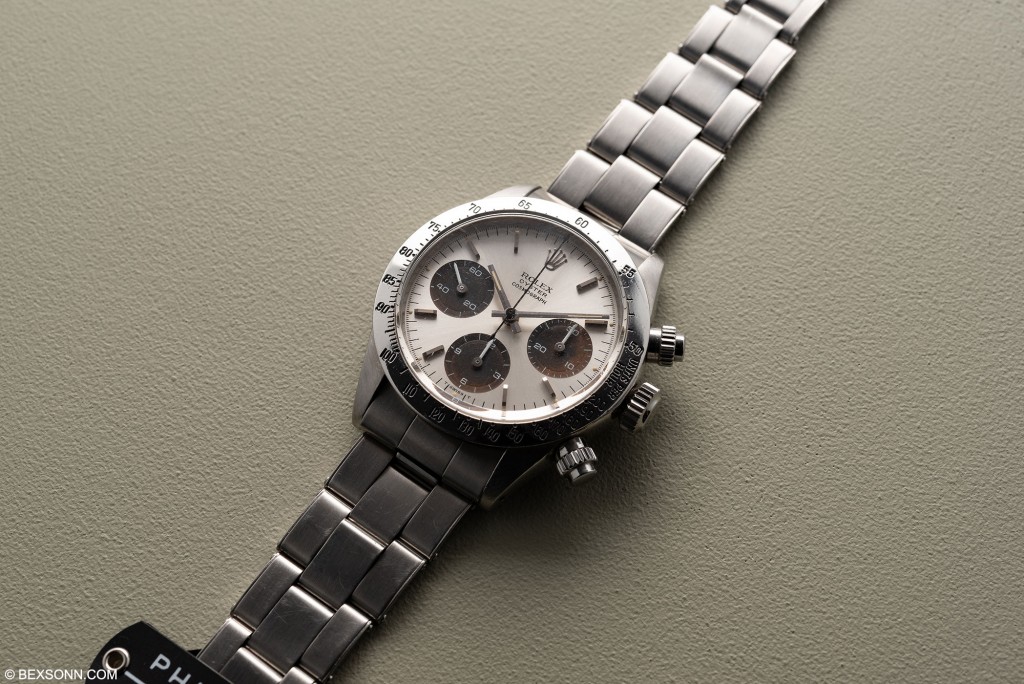 Lot 5: Most, if not all, of us are by now familiar with the Rolex Daytona but even till this day, when tasked to think about the quintessential sports chronograph of the last 5 decades, few will come to mind, but none are more iconic than the Rolex Daytona. As you know, the Daytona was introduced as a motor sport racing wristwatch, with earlier examples exhibiting pump push pieces but Rolex had always wanted to remain true to form and so introduced the 6240: their first Daytona to incorporate screw-down chronograph push pieces. The 6240 was quickly superseded by the 6263 & 6265, which were introduced circa 1969.
Lot 5: Most, if not all, of us are by now familiar with the Rolex Daytona but even till this day, when tasked to think about the quintessential sports chronograph of the last 5 decades, few will come to mind, but none are more iconic than the Rolex Daytona. As you know, the Daytona was introduced as a motor sport racing wristwatch, with earlier examples exhibiting pump push pieces but Rolex had always wanted to remain true to form and so introduced the 6240: their first Daytona to incorporate screw-down chronograph push pieces. The 6240 was quickly superseded by the 6263 & 6265, which were introduced circa 1969.
This early Daytona is perhaps to the layperson just another Daytona but look carefully and you’ll notice its black chronograph registers have turned a rich tobacco tone, with some areas of the sub dials at 3 and 6 o’clock displaying lighter hues of cappuccino. As you can see, each register has aged differently, giving this 6265 a rather unique character. You’ll also notice the dial is void of the wording “DAYTONA” which denotes this was an early execution. The case has been rather well-preserved considering its age and still retains its MK2 screw-down pushers. Furthermore, another trait which distinguishes this 6265 as an early generation Daytona is the fact its inside case back is engraved with the reference 6262, as Rolex used leftover case backs from earlier Cosmographs; a practice they used quite often.
Estimate: CHF40,000 – 60,000
ROLEX DATO-COMPAX “JCK” REF. 6236
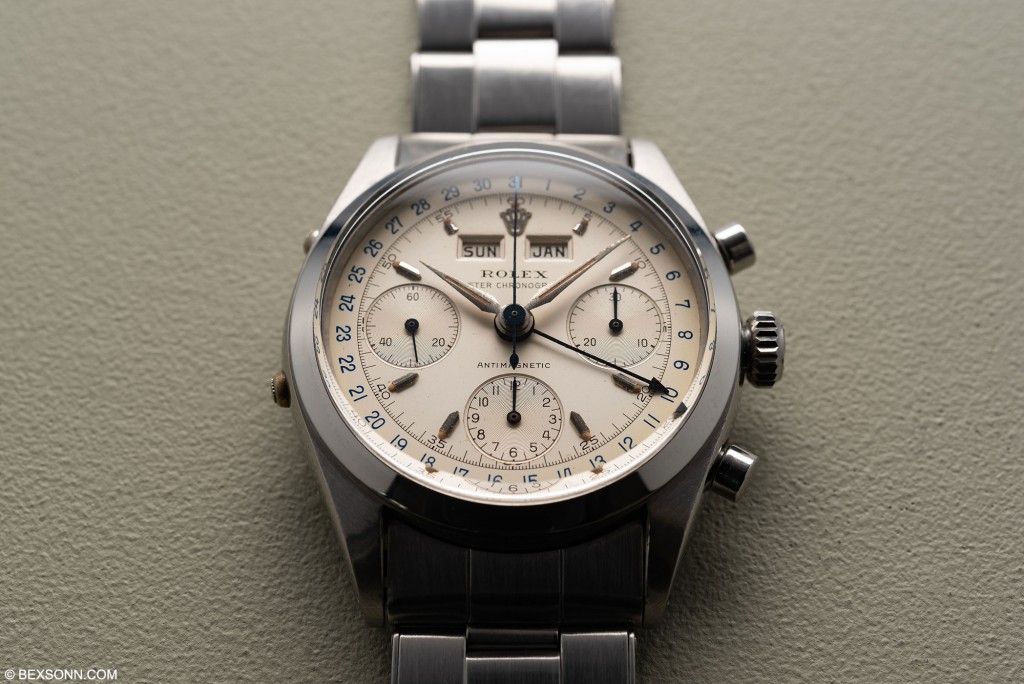 Lot 42: The Rolex “Jean-Claude Killy” Dato-Compax has always been an interesting piece but how it actually got its nickname is even more so. Jean-Claude owned a yellow gold 6036 and mentions it in the preface of a book in 1996. However, Antiquorum began using the ‘so-called Jean-Claude Killy’ for this reference around 1997/1998, since then the nickname has trickled down to all similar models regardless of reference. That said, it is widely thought that he owned the steel version but in fact the true JCK is yellow gold. In production for approximately 20 years, from the mid-1940s to the mid-1960s, during its lifespan only four references were made: the 4767, 5036, 6036 and 6236.
Lot 42: The Rolex “Jean-Claude Killy” Dato-Compax has always been an interesting piece but how it actually got its nickname is even more so. Jean-Claude owned a yellow gold 6036 and mentions it in the preface of a book in 1996. However, Antiquorum began using the ‘so-called Jean-Claude Killy’ for this reference around 1997/1998, since then the nickname has trickled down to all similar models regardless of reference. That said, it is widely thought that he owned the steel version but in fact the true JCK is yellow gold. In production for approximately 20 years, from the mid-1940s to the mid-1960s, during its lifespan only four references were made: the 4767, 5036, 6036 and 6236.
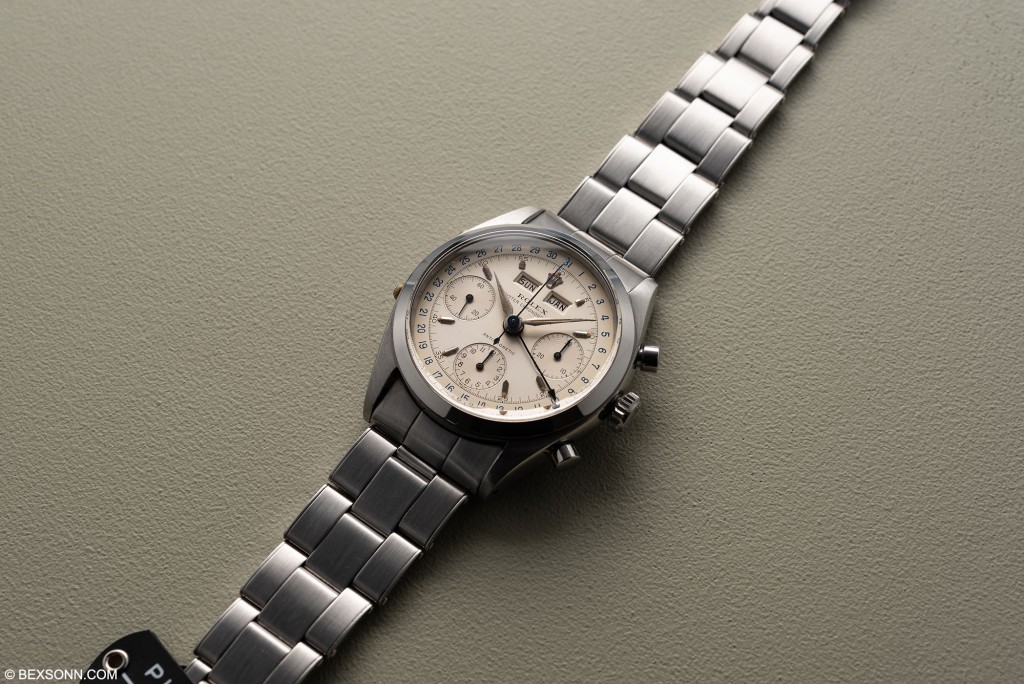 This 6236 appears to be in outstanding condition. The case appears to be crisp, with pronounced lugs and comes on an original hollow link riveted bracelet, which is in matching condition. The dial has a warm creamy patina to it, with the luminous plots to match. Furthermore, it has a little bit of interesting auction history. This lot originally belonged in the collection of Gordon Bethune, who was CEO of Continental Airlines from 1994 until 2004, when he retired. Mr. Bethune was known to be quite the watch collector and so in 2012 he put 50 of his best watches up for auction and this 6236 was one of the highlights, at the time breaking the record for any reference 6236 ever sold at auction. A record that it still holds today but will it be able to eclipse it – who knows?
This 6236 appears to be in outstanding condition. The case appears to be crisp, with pronounced lugs and comes on an original hollow link riveted bracelet, which is in matching condition. The dial has a warm creamy patina to it, with the luminous plots to match. Furthermore, it has a little bit of interesting auction history. This lot originally belonged in the collection of Gordon Bethune, who was CEO of Continental Airlines from 1994 until 2004, when he retired. Mr. Bethune was known to be quite the watch collector and so in 2012 he put 50 of his best watches up for auction and this 6236 was one of the highlights, at the time breaking the record for any reference 6236 ever sold at auction. A record that it still holds today but will it be able to eclipse it – who knows?
Estimate: CHF300,000 – 600,000
PATEK PHILIPPE 3974
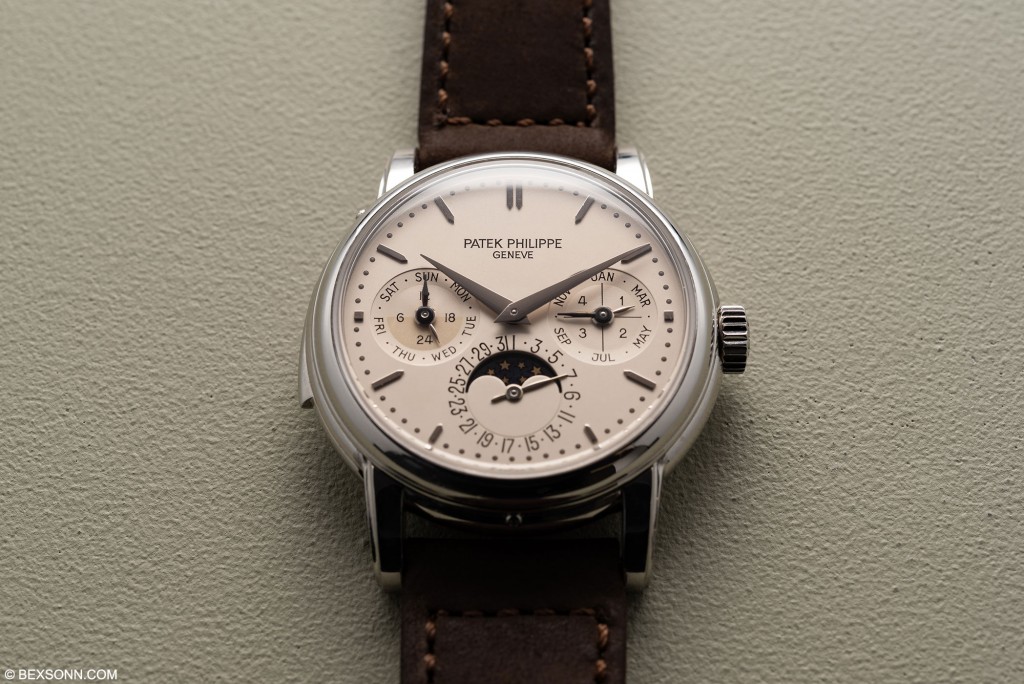 Lot 78A: Myself and fellow contributor, Sean Song (who actually owns a 3940) are big fans of the perpetual calendar moon phase 3940 that Patek introduced back in the 1980s, while Patek were under the stewardship of Philippe Stern. However, not many are aware there was also another piece introduced in the late 90s, made in the same vein to celebrate Patek’s 150th anniversary but featured an extra complication. The minute repeating perpetual calendar moon phase reference 3974, which at a glance bears loose similarities to the 3940 but look closer and you’ll soon notice the minute repeating lever on the left-hand side of the case.
Lot 78A: Myself and fellow contributor, Sean Song (who actually owns a 3940) are big fans of the perpetual calendar moon phase 3940 that Patek introduced back in the 1980s, while Patek were under the stewardship of Philippe Stern. However, not many are aware there was also another piece introduced in the late 90s, made in the same vein to celebrate Patek’s 150th anniversary but featured an extra complication. The minute repeating perpetual calendar moon phase reference 3974, which at a glance bears loose similarities to the 3940 but look closer and you’ll soon notice the minute repeating lever on the left-hand side of the case.
Featuring the in-house self-winding calibre 27RQ, with minute repeater, perpetual calendar, 24-hour indicator and phases of the moon – it was quite simply the most complicated wristwatch in the world when it was launched. This complicated movement was housed in a case that you’ll notice is reminiscent of the 2499. That’s because Patek used the same case maker of the 2499 (Jean-Pierre Hagmann) to produce the case for the 3974 too, with one of the most important criteria’s being that the case not only look beautiful but crisply resonate the repeaters chime.
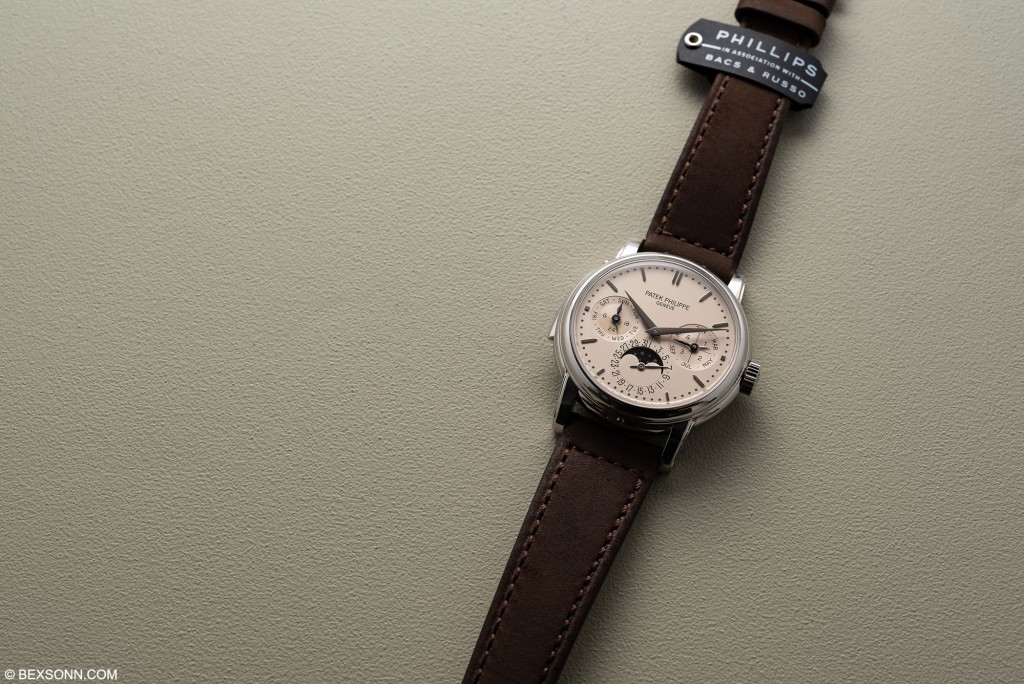 In 2000, Patek Philippe discontinued the 3974, giving a lifespan of 11 years but given how complicated the 3974 was to make it is estimated that no fewer than eight known examples were produced in platinum. That said, Platinum isn’t the greatest conductor of sound but Patek never look to the easiest option. And so, with their technical prowess and Hagmann’s expertise, you have here what is truly a masterpiece from Patek Philippe.
In 2000, Patek Philippe discontinued the 3974, giving a lifespan of 11 years but given how complicated the 3974 was to make it is estimated that no fewer than eight known examples were produced in platinum. That said, Platinum isn’t the greatest conductor of sound but Patek never look to the easiest option. And so, with their technical prowess and Hagmann’s expertise, you have here what is truly a masterpiece from Patek Philippe.
Estimate: CHF650,000 – 950,000
ROLEX CHRONOGRAPH REF. 6238 ‘ANTI-MAGNETIC’
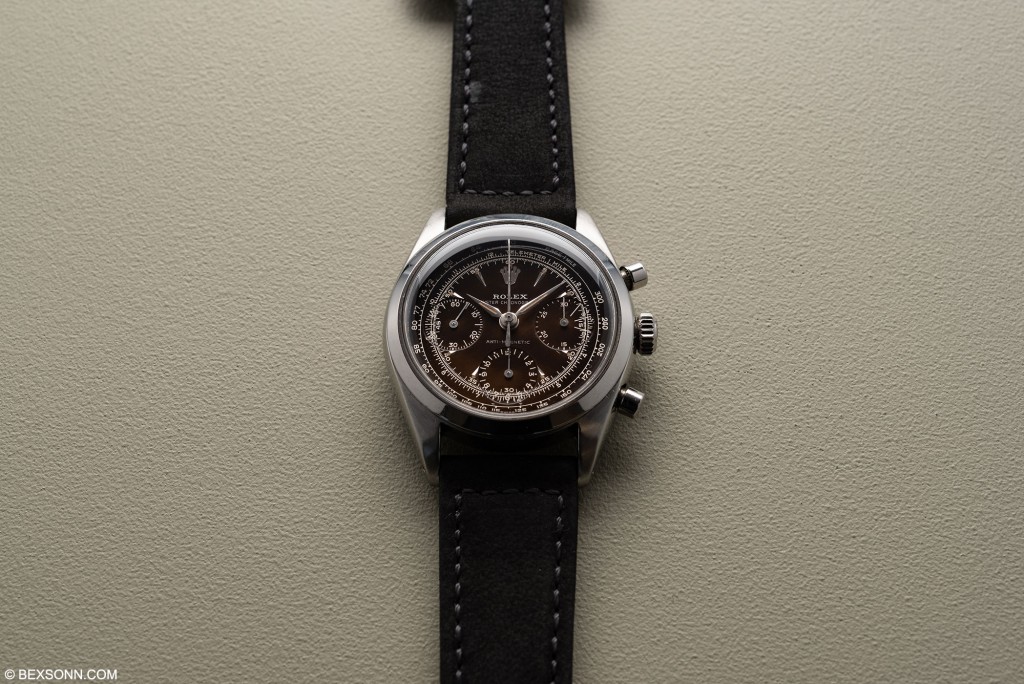 Lot 86: Rolex have quite the history with chronographs but what is quite interesting to learn is that this love affair with chronographs didn’t become apparent until around the 1930s and even then, it was in very small quantities. That said, it didn’t stop these early pieces from being some of the most coveted and fascinating pieces Rolex had ever produced. The 6238 is the precursor to the venerable Cosmograph Daytona, which was in fact the last model to feature a tachymetre scale on the dial and even looking back just a little further past the ‘Father’ of the Daytonas, you will indeed find the 6234, which bears uncanny resemblance to this present lot – often referred to as the ‘Godfather’ of Daytonas.
Lot 86: Rolex have quite the history with chronographs but what is quite interesting to learn is that this love affair with chronographs didn’t become apparent until around the 1930s and even then, it was in very small quantities. That said, it didn’t stop these early pieces from being some of the most coveted and fascinating pieces Rolex had ever produced. The 6238 is the precursor to the venerable Cosmograph Daytona, which was in fact the last model to feature a tachymetre scale on the dial and even looking back just a little further past the ‘Father’ of the Daytonas, you will indeed find the 6234, which bears uncanny resemblance to this present lot – often referred to as the ‘Godfather’ of Daytonas.
There are 6238s and there are 6238s, of which this is the latter. Like most timepieces produced during this period, this example features the rarer black lacquer dial but what makes this piece extra special, is the dial’s ‘tropical’ nature, which has turned it from a deep piano black to a warm, tobacco glow. But that isn’t everything, there’s more…
 The 60s were considered to be a transitional period for many watch manufacturers as they attempted to move away from the much harmful substance of radium to tritium. It is widely accepted that Rolex first signified this change with the use of a small horizontal line on the dial – also known as the “Underline Dial.” However, this was rather unclear and so Rolex went down the route of using small T’s, usually flanking the wording “SWISS” – denoting tritium had been used. This meant that old stock dials had to be modified to denote this change by using, as already mentioned, an “underline” or “T” on the dial. In most cases this addition is quite noticeable, as the colour slightly differs from the original text, but this subtle difference makes these examples extremely collectible today.
The 60s were considered to be a transitional period for many watch manufacturers as they attempted to move away from the much harmful substance of radium to tritium. It is widely accepted that Rolex first signified this change with the use of a small horizontal line on the dial – also known as the “Underline Dial.” However, this was rather unclear and so Rolex went down the route of using small T’s, usually flanking the wording “SWISS” – denoting tritium had been used. This meant that old stock dials had to be modified to denote this change by using, as already mentioned, an “underline” or “T” on the dial. In most cases this addition is quite noticeable, as the colour slightly differs from the original text, but this subtle difference makes these examples extremely collectible today.
This particular 6238 features a dial from that transitional period but also has a seldom seen nuance too. The Ts on this example don’t flank the wording “SWISS” but instead are suspended above the tach-o-meter scale. Likely done this way because of the scarce space either side of Swiss. While this is unusual, it just goes to show how off-the-cuff Rolex were at the time in making quick decisions to continue shipment, thus giving the collecting community such rare examples.
Estimate: CHF250,000 – 500,000
ROLEX EXPLORER 6610
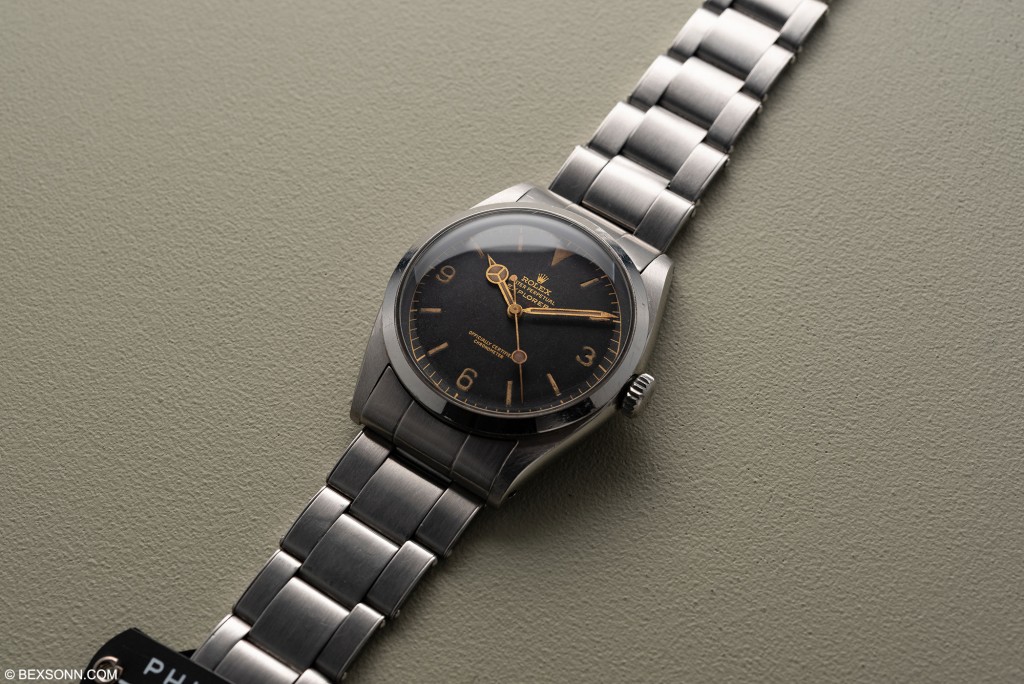 Lot 95: It perhaps goes without saying that I’ve always been a massive admirer of the simple and humble Rolex Explorer. It’s just an elegant and functional watch. Rolex launched the reference 6610 as a new generation “Explorer” wristwatch. It housed the slim calibre 1030 movement that allowed for a flatter case back. This gave the Explorer a more modern and sleek appearance compared with earlier references fitted with the thicker calibre and required a rounded “bubble back” type case, though these earlier Explorer’s are still highly collectible.
Lot 95: It perhaps goes without saying that I’ve always been a massive admirer of the simple and humble Rolex Explorer. It’s just an elegant and functional watch. Rolex launched the reference 6610 as a new generation “Explorer” wristwatch. It housed the slim calibre 1030 movement that allowed for a flatter case back. This gave the Explorer a more modern and sleek appearance compared with earlier references fitted with the thicker calibre and required a rounded “bubble back” type case, though these earlier Explorer’s are still highly collectible.
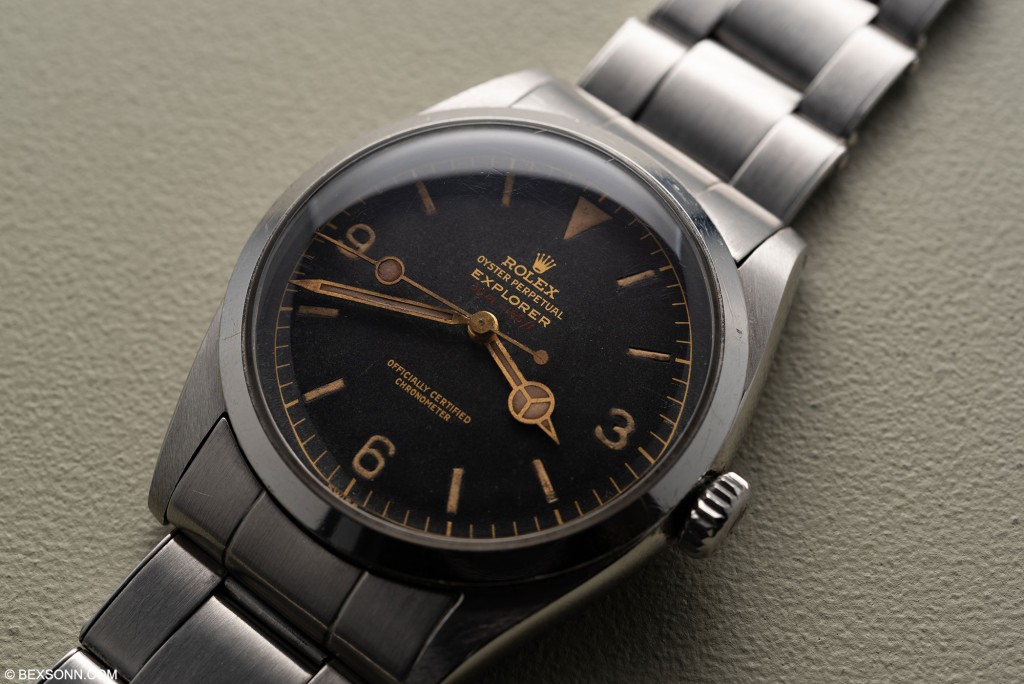 This Explorer 6610 features the classic black glossy, gilt dial and 3-6-9 hour numeral layout that defined the Rolex “Explorer” model. The reference 6610 is unusual for their standard gilt lettering and “Officially Certified Chronometer” designation. That said, this is no ordinary 6610 Explorer. What truly makes this 6610 extremely rare and highly collectible, is the red depth rating just below the gilt Explorer designation – something seldom seen. Furthermore, it comes complete with its box, papers, guarantee, hang tags and chronometer certification.
This Explorer 6610 features the classic black glossy, gilt dial and 3-6-9 hour numeral layout that defined the Rolex “Explorer” model. The reference 6610 is unusual for their standard gilt lettering and “Officially Certified Chronometer” designation. That said, this is no ordinary 6610 Explorer. What truly makes this 6610 extremely rare and highly collectible, is the red depth rating just below the gilt Explorer designation – something seldom seen. Furthermore, it comes complete with its box, papers, guarantee, hang tags and chronometer certification.
Estimate: CHF30,000 – 60,000
ROLEX CHRONOGRAPH REF. 6234 ‘ANTI-MAGNETIC’
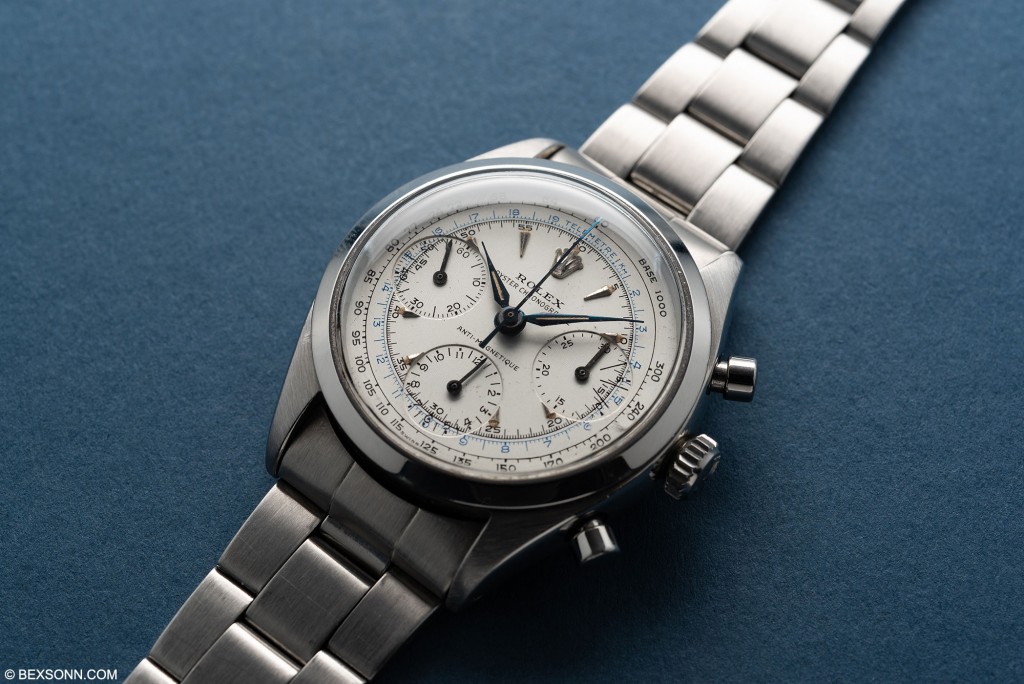 Lot 209: We’ve already highlighted a Rolex Chronograph ref. 6238 above that in appearance doesn’t look too dissimilar, so I won’t get into the minutiae of the reference 6234 too much. But, as mentioned above it is considered to be the “Godfather” of the Daytona. This example features a white dial, that has a warm patina to it, with vibrant blue telemeter scale and matching hands, which is stark in contrast but works very well. Just like most other Rolex chronographs from the era, this 1960s example houses a Valjoux 72 but this isn’t the reason we’ve chosen to highlight it. Perhaps the most important thing to consider when collecting anything, is condition and this 6234 is immaculate. The stainless-steel case not only appears but feels so well-preserved, retaining its sharp edges and surfaces.
Lot 209: We’ve already highlighted a Rolex Chronograph ref. 6238 above that in appearance doesn’t look too dissimilar, so I won’t get into the minutiae of the reference 6234 too much. But, as mentioned above it is considered to be the “Godfather” of the Daytona. This example features a white dial, that has a warm patina to it, with vibrant blue telemeter scale and matching hands, which is stark in contrast but works very well. Just like most other Rolex chronographs from the era, this 1960s example houses a Valjoux 72 but this isn’t the reason we’ve chosen to highlight it. Perhaps the most important thing to consider when collecting anything, is condition and this 6234 is immaculate. The stainless-steel case not only appears but feels so well-preserved, retaining its sharp edges and surfaces.
Estimate: CHF25,000 – 40,000
COSMOGRAPH DAYTONA ‘PAUL NEWMAN’ REF. 6263
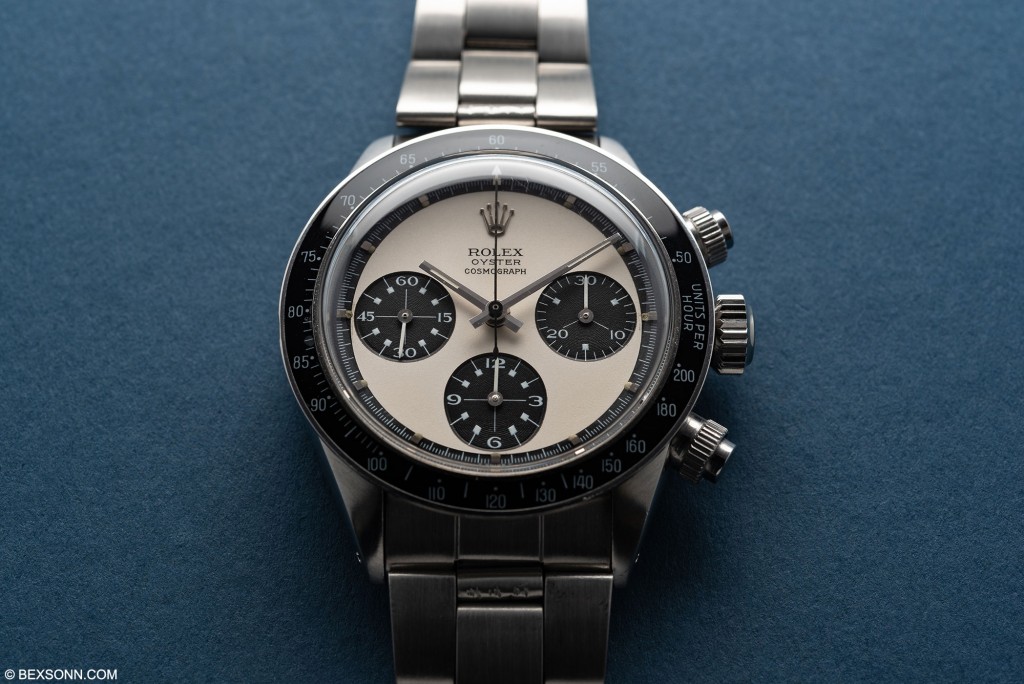 Lot 215: We’ve spoken a lot here on BEXSONN about “Paul Newman” Daytonas, so I won’t go into the little details which makes each version special. However, it would be hard to look at any Phillips Watches auction and not mention the iconic ‘Paul Newman’ Daytona – they are after all responsible for selling the world’s most expensive Paul Newman Daytona. It is without doubt, the most sought-after Daytona example of them all – it is hot property and the bad news for anyone looking to possibly add one to their collection is this trend is only set to continue onwards and upwards. Nonetheless, exotic 6263s aren’t particularly rare, however, this present lots condition is quite outstanding. This example features a MK2 “Panda” dial that is exceptionally clean and sharp, with some nice patination to match its age. But what makes this 6263 standout even more is it’s condition. It features a well-preserved case as well as original ‘millerighe’ pushers, correct bezel and bracelet. Even more, it’s offered with its Rolex Guarantee dated July 27, 1972, along with original box.
Lot 215: We’ve spoken a lot here on BEXSONN about “Paul Newman” Daytonas, so I won’t go into the little details which makes each version special. However, it would be hard to look at any Phillips Watches auction and not mention the iconic ‘Paul Newman’ Daytona – they are after all responsible for selling the world’s most expensive Paul Newman Daytona. It is without doubt, the most sought-after Daytona example of them all – it is hot property and the bad news for anyone looking to possibly add one to their collection is this trend is only set to continue onwards and upwards. Nonetheless, exotic 6263s aren’t particularly rare, however, this present lots condition is quite outstanding. This example features a MK2 “Panda” dial that is exceptionally clean and sharp, with some nice patination to match its age. But what makes this 6263 standout even more is it’s condition. It features a well-preserved case as well as original ‘millerighe’ pushers, correct bezel and bracelet. Even more, it’s offered with its Rolex Guarantee dated July 27, 1972, along with original box.
Estimate: CHF350,000 – 550,000
OMEGA TRILOGY
Back in 1957, Omega released three watches, which would go on to become not just famous but household classics among the watch collecting fraternity. The Seamaster 300, Railmaster and of course Speedmaster. These three watches all represented 3 various fields for use. The Seamaster, by virtue was destined for divers, the Railmaster (while perhaps not initially evident) was made with scientist who worked in environments of high magnetism in mind and last but not least the Speedmaster, which was originally made with racing drivers in-mind, but we all know where that story ends up.
SEAMASTER CK2913
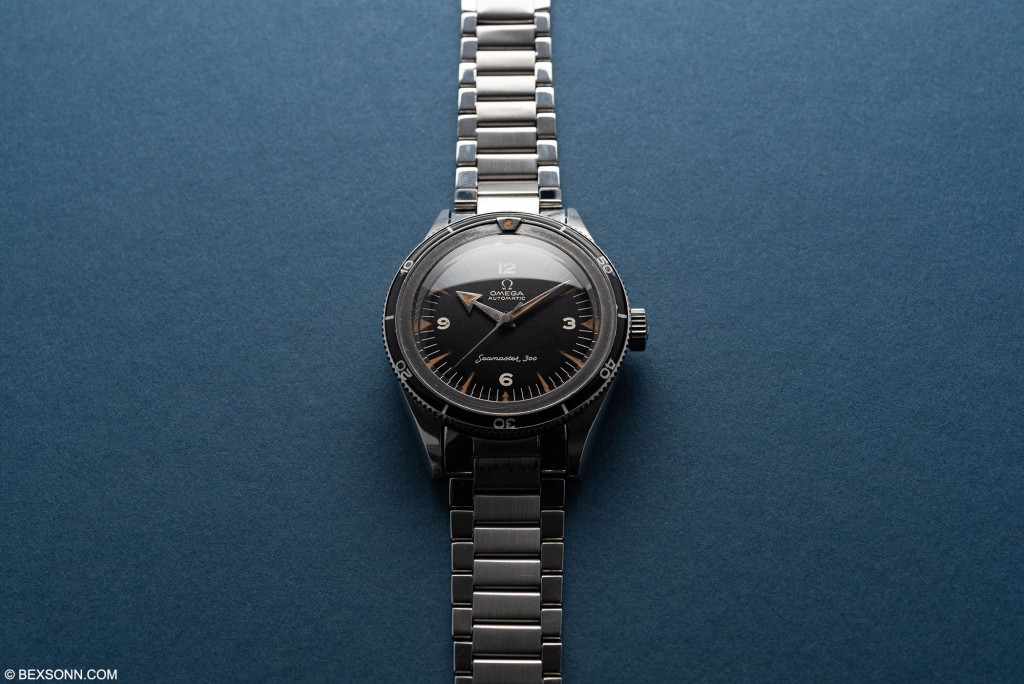 Lot 113: As mentioned, the very first Seamaster ref. CK2913 was introduced to be a divers much needed companion but it also became rather sought-after. It had all the attributes that any diver would need, packaged in a very stylish watch that later became iconic. The CK2913 was introduced in 1957 but it is interesting to note that while it bore 300 on the dial, it was only water-resistant to 200 metres. The story goes that it should’ve been water-resistant to 300 metres but at the time, the testing equipment used could only measure a depth of 200 metres – whether this is factual or not is unknown. However, one ingenious design from the folks at Omega was the Naïad crown. Naïad (meaning water nymph in Ancient Greek) was a technology integrated into the crown but how exactly did this work? The original Seamaster used a Naïad crown, which Omega also used on the Railmaster and Speedmaster. The crown improves on the water resistance of the watch as the pressure increases the crown seals further.
Lot 113: As mentioned, the very first Seamaster ref. CK2913 was introduced to be a divers much needed companion but it also became rather sought-after. It had all the attributes that any diver would need, packaged in a very stylish watch that later became iconic. The CK2913 was introduced in 1957 but it is interesting to note that while it bore 300 on the dial, it was only water-resistant to 200 metres. The story goes that it should’ve been water-resistant to 300 metres but at the time, the testing equipment used could only measure a depth of 200 metres – whether this is factual or not is unknown. However, one ingenious design from the folks at Omega was the Naïad crown. Naïad (meaning water nymph in Ancient Greek) was a technology integrated into the crown but how exactly did this work? The original Seamaster used a Naïad crown, which Omega also used on the Railmaster and Speedmaster. The crown improves on the water resistance of the watch as the pressure increases the crown seals further.
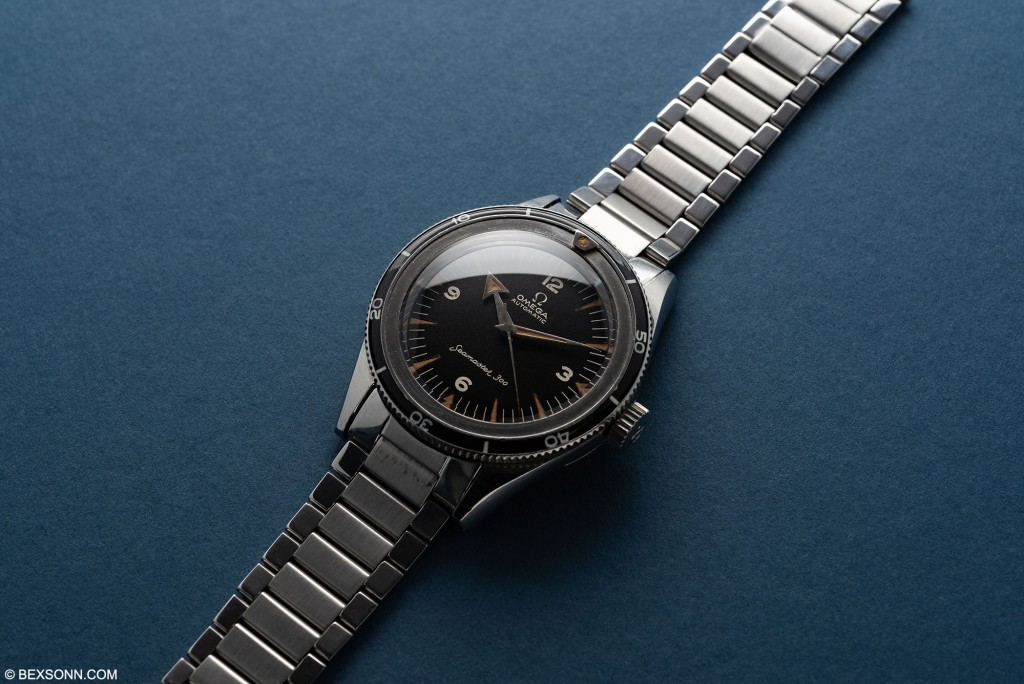 Beating away inside the Seamaster 300, was Omega’s tried and tested, hassle free, cal. 501. Known as the mother of all Omega diving watches, the Seamaster 300 was pretty much Omega’s answer to the Rolex Submariner and aesthetic similarities can be seen. However, the Seamaster 300 never really got the fame the Submariner received but among its faithful fans it is an absolute gem. This present lot is a perfect example of a Seamaster 300. It is in excellent condition, with a nice build-up of patina on the luminous markers and famed “Broad Arrow” hands. Rather interestingly, the fragile bakelite bezel, which was prone to shattering remains intact. This Seamaster 300 was made in 1959 and delivered to Sweden, as noted by its Omega archive extract, and it would appear it hasn’t aged much in its nearly 60 years.
Beating away inside the Seamaster 300, was Omega’s tried and tested, hassle free, cal. 501. Known as the mother of all Omega diving watches, the Seamaster 300 was pretty much Omega’s answer to the Rolex Submariner and aesthetic similarities can be seen. However, the Seamaster 300 never really got the fame the Submariner received but among its faithful fans it is an absolute gem. This present lot is a perfect example of a Seamaster 300. It is in excellent condition, with a nice build-up of patina on the luminous markers and famed “Broad Arrow” hands. Rather interestingly, the fragile bakelite bezel, which was prone to shattering remains intact. This Seamaster 300 was made in 1959 and delivered to Sweden, as noted by its Omega archive extract, and it would appear it hasn’t aged much in its nearly 60 years.
Estimate: CHF40,000 – 60,000
RAILMASTER CK2914
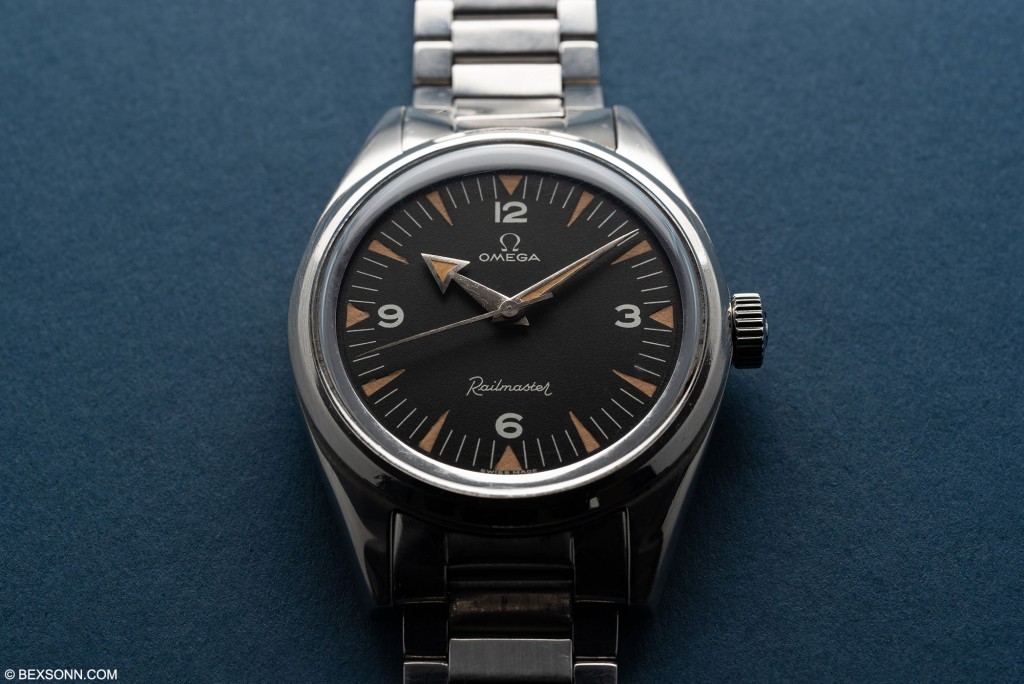 Lot 112: The Railmaster CK2914, was designed as a tool watch; it was simple yet elegant but had a particular purpose. The double-case anti-magnetic watch was specially designed for scientists, technicians or anyone who worked close to electrical fields. Released in 1957, the Railmaster had a specially constructed case, dial, movement and dust cover using materials to shield against magnetic activity. The movement was copper finished and protected by a special double case and iron dust cover making it Omega’s first 1000 gauss anti-magnetic watch.
Lot 112: The Railmaster CK2914, was designed as a tool watch; it was simple yet elegant but had a particular purpose. The double-case anti-magnetic watch was specially designed for scientists, technicians or anyone who worked close to electrical fields. Released in 1957, the Railmaster had a specially constructed case, dial, movement and dust cover using materials to shield against magnetic activity. The movement was copper finished and protected by a special double case and iron dust cover making it Omega’s first 1000 gauss anti-magnetic watch.
As mentioned, the Railmaster when introduced could resist a magnetic force of up to 1000 Gauss or 0.1 Tesla, thanks to the Faraday Cage protection. By placing a NuMetal (a branded name for soft iron) plate on the case back, Omega were able to protect the movement inside from magnetic fields. Omega chose to use 30T2 base movement for the Railmaster which would be renamed the calibres 284, 285 and 286 throughout its years of use. However, one thing that maligned the Railmaster, was its relatively short production run, of course starting in 1957 but ending in 1963, something that didn’t affect its trilogy counterparts. Because of its somewhat short production run, this makes the Railmaster one of the rarest pieces of the trilogy but not one of the most collectible.
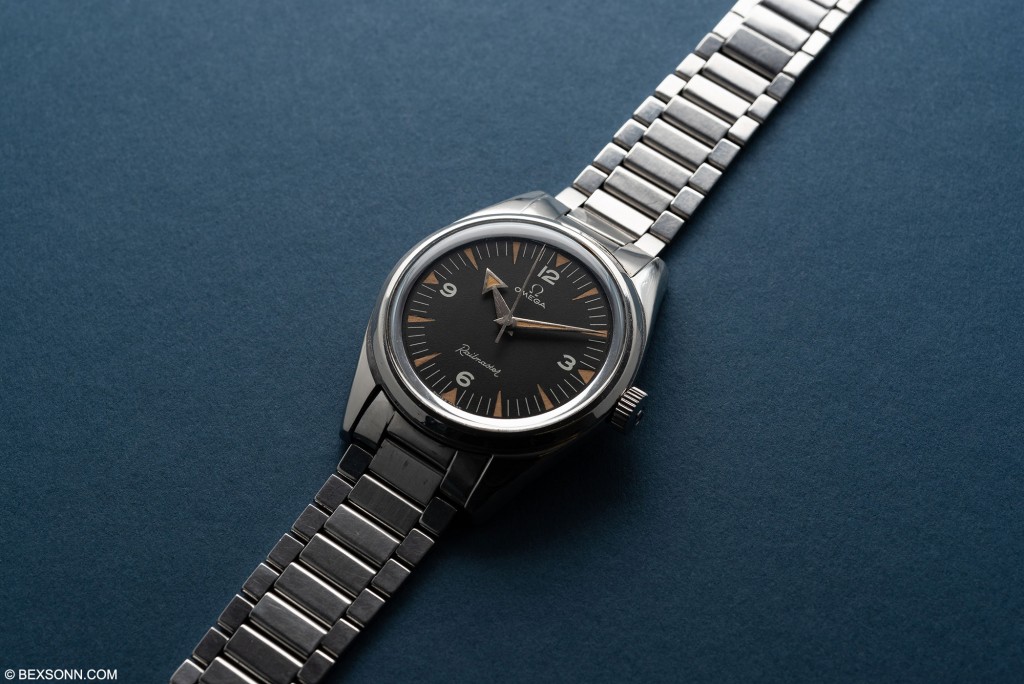 The Railmaster CK2914 was very similar to the Seamaster 300 at the time and both cased near identical black dials, which featured 3, 6, 9 and 12 with triangles marking each quarter hour and elongated arrows marking the rest of the hour marks. Both also sported “Broad Arrow” hands but the key differentiator was the dials thickness, which was just 1 mm thick as opposed to the normal 0.4 mm thick, an element of its anti-magnetisms. This Railmaster was made in 1957 and delivered to Australia, as noted by its Omega archive extract, and like the Seamaster 300 above, it remains in excellent condition.
The Railmaster CK2914 was very similar to the Seamaster 300 at the time and both cased near identical black dials, which featured 3, 6, 9 and 12 with triangles marking each quarter hour and elongated arrows marking the rest of the hour marks. Both also sported “Broad Arrow” hands but the key differentiator was the dials thickness, which was just 1 mm thick as opposed to the normal 0.4 mm thick, an element of its anti-magnetisms. This Railmaster was made in 1957 and delivered to Australia, as noted by its Omega archive extract, and like the Seamaster 300 above, it remains in excellent condition.
Estimate: CHF30,000 – 50,000
SPEEDMASTER CK2915
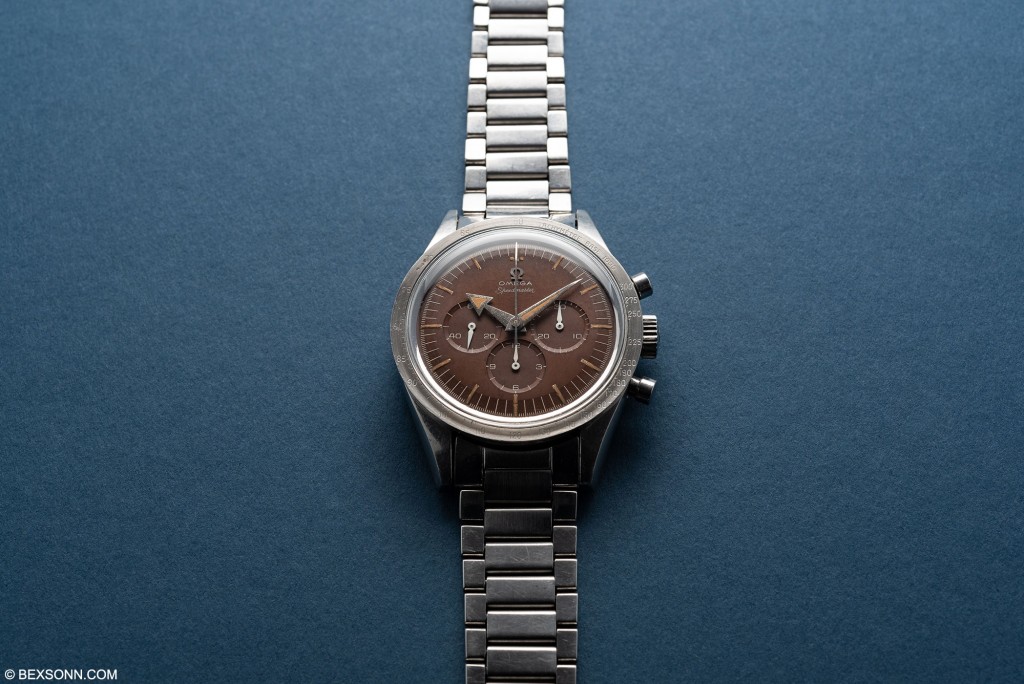 As mentioned, the original Speedmaster, also dubbed the “Broad Arrow” because of its unique hands, was not only the first Speedmaster, it was also the first chronograph wristwatch in the world with its tachymeter scale on the bezel as opposed to printed on the dial. Omega were the first watch manufacturer to ever do this, all the way back in 1957, on a wristwatch and other brands soon followed suit. Originally a watch designed to benefit racing drivers but it went on to become famously associated with Astronauts.
As mentioned, the original Speedmaster, also dubbed the “Broad Arrow” because of its unique hands, was not only the first Speedmaster, it was also the first chronograph wristwatch in the world with its tachymeter scale on the bezel as opposed to printed on the dial. Omega were the first watch manufacturer to ever do this, all the way back in 1957, on a wristwatch and other brands soon followed suit. Originally a watch designed to benefit racing drivers but it went on to become famously associated with Astronauts.
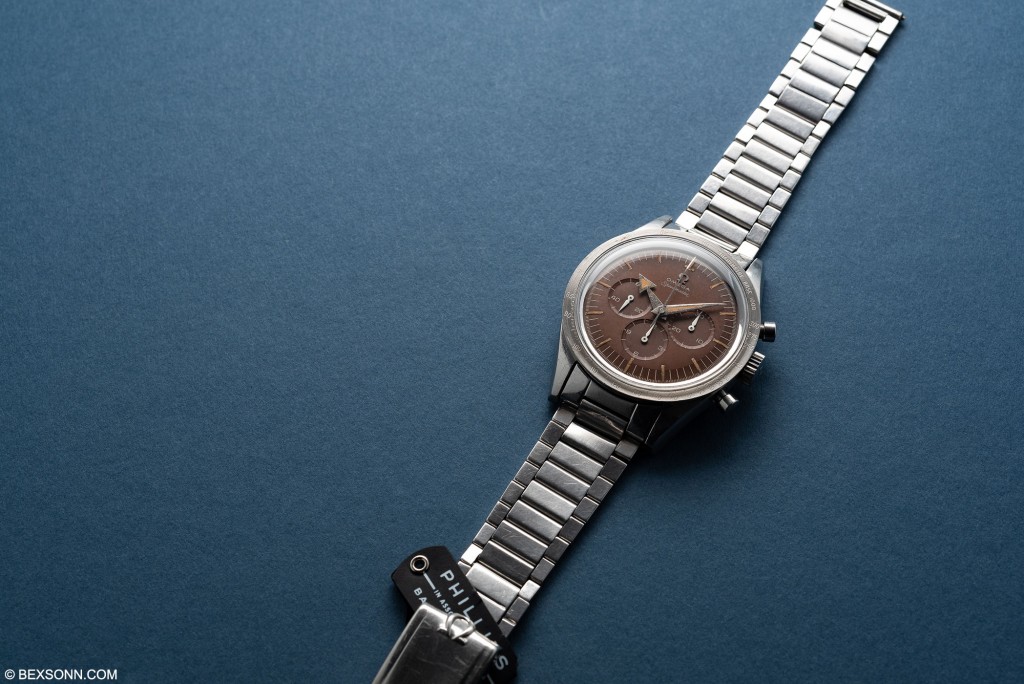 There are two CK2915 Speedmasters in this Phillips Geneva Watch Auction Eight sale. Lot 111: is the very first iteration; a -1. This example features a very sought-after patinated dial. The dial of this -1 from 1958 has turned from the deep matte black to a light milk chocolate-brown, otherwise known as “Tropical”. Records confirm this watch was originally delivered to Singapore, which is perhaps were it picked up its tropical nature. This particular lot also features the typical traits which confirm it is indeed a very early example, such as: the first-generation bezel that has “flat top 3”, a first gen double bevel case back, with no seahorse and the wording “SPEEDMASTER” engraved into the outer edge. As well as an expandable Omega bracelet with 6 end pieces, making it quite the attractive lot for any collector.
There are two CK2915 Speedmasters in this Phillips Geneva Watch Auction Eight sale. Lot 111: is the very first iteration; a -1. This example features a very sought-after patinated dial. The dial of this -1 from 1958 has turned from the deep matte black to a light milk chocolate-brown, otherwise known as “Tropical”. Records confirm this watch was originally delivered to Singapore, which is perhaps were it picked up its tropical nature. This particular lot also features the typical traits which confirm it is indeed a very early example, such as: the first-generation bezel that has “flat top 3”, a first gen double bevel case back, with no seahorse and the wording “SPEEDMASTER” engraved into the outer edge. As well as an expandable Omega bracelet with 6 end pieces, making it quite the attractive lot for any collector.
Estimate: CHF150,000 – 300,000
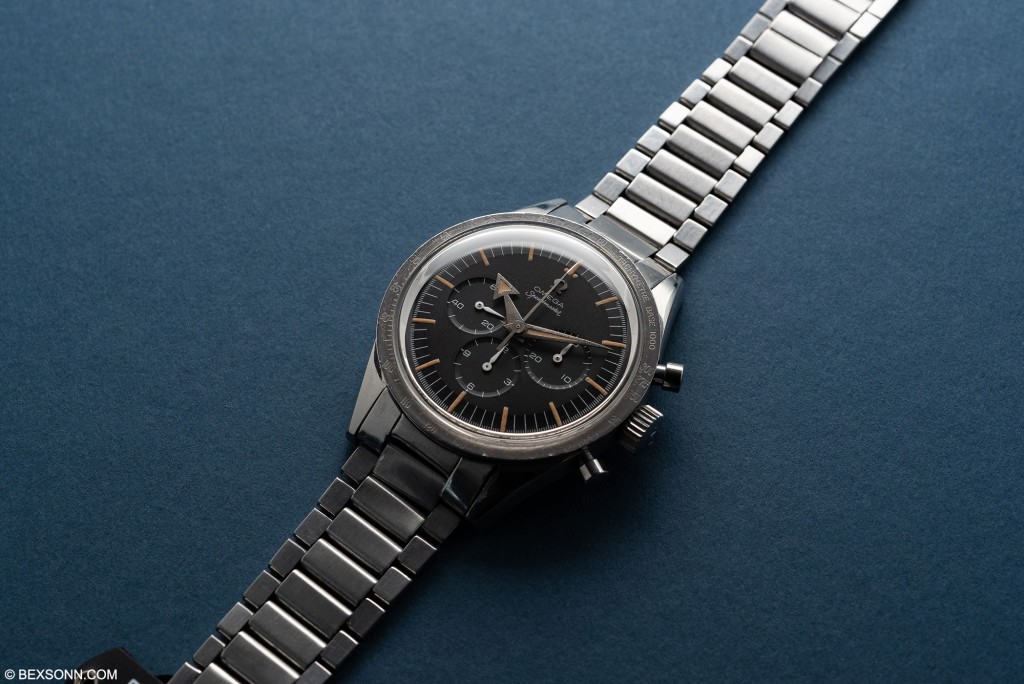 The second of the two CK2915 Speedmasters from this auction is Lot 114: a -2, while perhaps not as important as lot 111, it is still just as remarkable. From a personal standpoint, this Speedmaster CK2915-2 is my favourite of the two. Why? Certain watches look better with tropical dials and some don’t and for me the CK2915 Speedmaster is one of them. This -2 from 1959, has been preserved in brilliant condition, featuring a perfect matte black dial and lume that has patinated to a lovely warm cream hue. This -2 displays all correct features of a second gen CK2915. It sports a ‘Base 1000’ bezel, while the dial displays an Omega signature that features the iconic ‘fat’ O followed by the slightly longer ‘r’ in the Speedmaster signature, all correct for this period. Furthermore, this lot comes accompanied by its original box and guarantee booklet, making it again another attractive lot for someone looking for an early Speedmaster.
The second of the two CK2915 Speedmasters from this auction is Lot 114: a -2, while perhaps not as important as lot 111, it is still just as remarkable. From a personal standpoint, this Speedmaster CK2915-2 is my favourite of the two. Why? Certain watches look better with tropical dials and some don’t and for me the CK2915 Speedmaster is one of them. This -2 from 1959, has been preserved in brilliant condition, featuring a perfect matte black dial and lume that has patinated to a lovely warm cream hue. This -2 displays all correct features of a second gen CK2915. It sports a ‘Base 1000’ bezel, while the dial displays an Omega signature that features the iconic ‘fat’ O followed by the slightly longer ‘r’ in the Speedmaster signature, all correct for this period. Furthermore, this lot comes accompanied by its original box and guarantee booklet, making it again another attractive lot for someone looking for an early Speedmaster.
Estimate: CHF150,000 – 250,000
FINAL WORD
So that’s that, my favourite lots from the Geneva Watch Auction: Eight. Phillips seem to continue to bring rare pieces to the market. That said, I don’t think their auction this time round has the super rare pieces we have perhaps become accustomed to seeing, I think the accolade this auction season belongs to Sotheby’s. Nonetheless, there are still a few sleepers in there they may surprise a few of us, so I will happily be watching to see how well these lots will perform.
For more lot information on The Phillips Geneva Watch Auction: EIGHT that will take place on the weekend of the 10th & 11th of November at La Reserve Hotel, Geneva, visit the official Phillips Watches website to view the entire catalogue.
